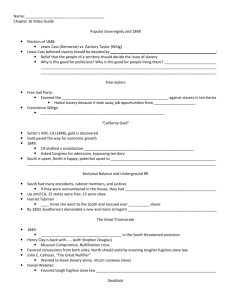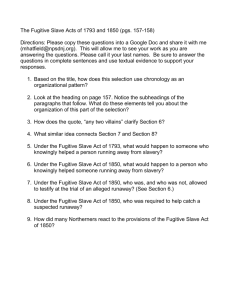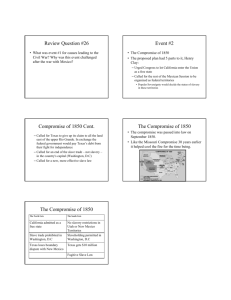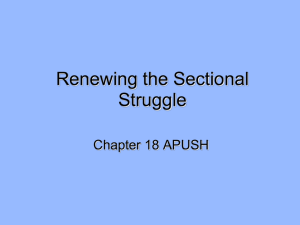Chapter 18 - Greenwood County School District 52
advertisement
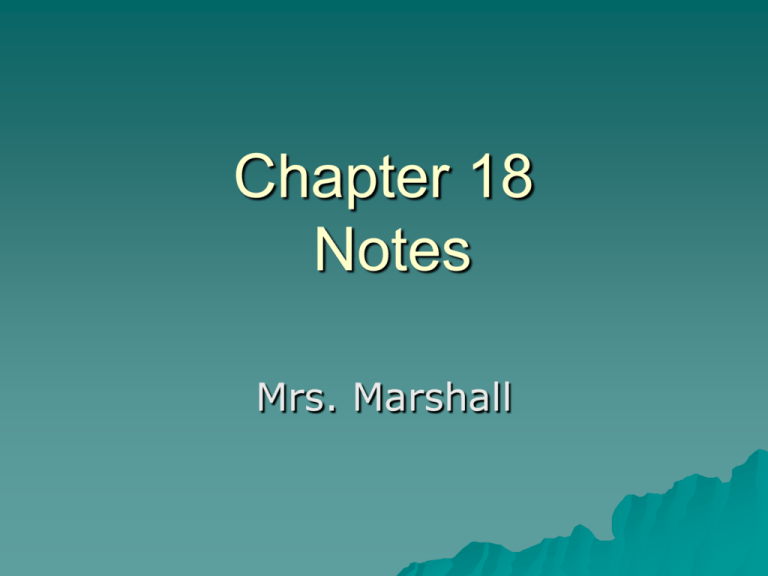
Chapter 18 Notes Mrs. Marshall By 1850 the South was well of both politically and economically. Zachary Taylor, southern born slaveholder, was President. South had a majority serving in the cabinet and on the US Supreme Court. 15 slave states Cotton fields were expanding and the price of cotton was good. Underground Railroad Refers to the effort to assist people held in bondage to escape from slavery. Used railroad terms: “stations” and “depots”- the homes and businesses where fugitive slave would rest and eat “stationmasters”- people who ran the homes and businesses “stockholders” people who contributed money or goods “conductor”- person responsible for moving fugitives from one station to another Stations averaged being about 20 miles in distance. Levi Coffin- a Quaker who assisted more than 3,000 slaves Harriet Tubman- made 19 trips into the south and escorted over 300 slaves to freedom. California applied for admission into the union as a free state. This would undo the equal balance in the Senate. Henry Clay- wanted the North and South to compromise and the north to agree to a stronger fugitive slave law. Stephen Douglas supported Clay. John C. Calhoun- said current fugitive slave laws were not strong enough. Daniel Webster- favored a stronger fugitive slave law but said nature would decide areas which would be slave or free states by climate and terrain of the land. “Seventh of March” speech(1850) helped lead to compromise William Henry Seward young senator from NY-highly opposed system of slavery, opposed any type of compromise Henry Clay- introduced an omnibus bill (relating to or containing many items) to deal with the issues of slavery. Opposed by Taylor, had no chance of passing Taylor died July of 1850 and Millard Fillmore became President. Stephen Douglas a northern Democrat, resurrected Clay’s bill and had it passed piece by piece. Fillmore signed the series of compromises that passed Congress Compromise of 1850 1-California was admitted into the union as a free state-this appeased the north 2-Stronger Fugitive Slave Law was passed (known as the Bloodhound Bill) 3- Territories of New Mexico and Utah would decide the issue of slavery by popular sovereignty at time of admission 4- Slave Trade, but not slavery was abolished in the District of Columbia 5-Texas boundary was cut down by almost half and Texas debt was assumed by the federal government Northerners did everything they could to undermine the Fugitive Slave Act. – Massachusetts made it a penal offense for any state official to enforce the new law – States passed “personal liberty laws” which hampered enforcement Election of 1852 Democrats nominated Franklin Pierce Whigs nominated Winfield Scott. Both avoided issues of slavery and sectionalism. Pierce was elected. Whig party split over the issue of slavery. Never nominated another presidential candidate. Party soon disappeared. Nicaragua William Walker tried to gain control of this Central American country in the 1850’s. Using force he declared himself president in July 1856 and legalized slavery. Coalition of Central American nations formed an alliance to overthrow him. His plan failed. Great Britain was interested in Nicaragua because they feared the northern part of the US would monopolize trade there. Clayton-Bulwer Treaty (1850) Stated that neither American nor Britain would fortify or secure exclusive control over any future isthmian waterway. Matthew Perry- opened trade in Japan to the United States. Obtained a treaty permitting trade and the opening of Japanese ports to US merchant ships. The south was interested in Cuba because of the large slave population and the sugar plantations. Could make several states out of Cuba and maintain equal balance in the senate. Narcisco Lopez Planned an expedition to Cuba in 1848- was ended by President Taylor. 2 years later another unsuccessful expedition was attempted. 1851 a 3rd expedition gained a foothold on the island but ended in complete defeat and capture /execution of 50 southerners who had participated along with Lopez. Ostend Manifesto a secret document written in 1854 by US diplomats at Ostend, Belgium describing a plan to acquire Cuba from Spain. On orders from Sec. of State, William Marcy, 3 us diplomats (minister to Britain, France and Spain) devised a plan to purchase Cuba-if Spain refused the offer it suggested the US take Cuba by force. News of the document leaked out-became public knowledge-caused outrage among northerners-President Pierce was forced to forget his scheme. Harriet Beecher Stowe author of Uncle Tom’s Cabin. Published in 1852-inspired by the Fugitive Slave Law. Stephen Douglas-senator from Illinois. Wanted to organize territory west of Illinois so that a transcontinental railroad could be constructed. Kansas-Nebraska Act Passed in 1854. Allowed people in the territories of Kansas and Nebraska to decide for themselves whether of not to allow slavery within their borders. 1- It repealed the Missouri Compromise of 1820. Infuriated many in the north who considered the compromise to be a binding agreement. 2- The Pro-slavery south supported the Kansas-Nebraska Act. Douglas’ motivation in introducing the bill: Trying to gain southern support for his presidential ambitions His beliefs in the principles of self-determination and selfgovernment His northern railroad interest which was contrary to Pierce’s interest in a southern route His beliefs that nature would preclude slavery from going into certain geographic areas regardless of popular sovereignty




